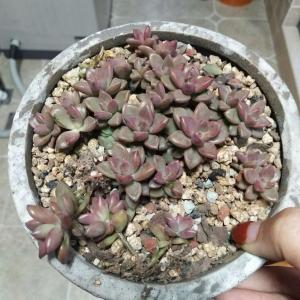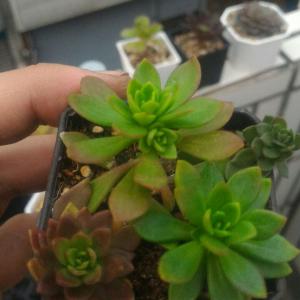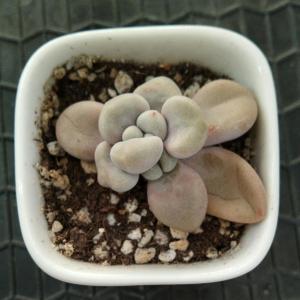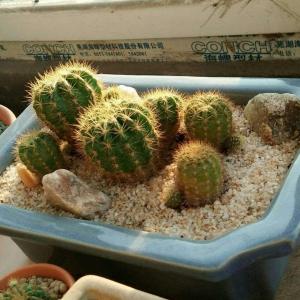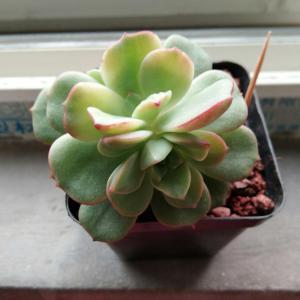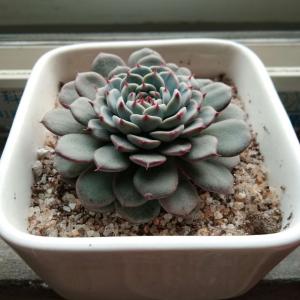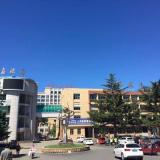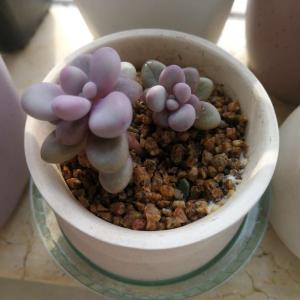文章
Miss Chen
2018年01月10日

Description: This is an annual wildflower with a large and stout central stem about 3-9' tall, although occasionally smaller. Toward the apex of the plant, there may be a few side stems, but it is tall and columnar overall. The central stem is light green to reddish green, terete, and covered with stiff spreading hairs. The large alternate leaves are up to 8" long and 6" across – they have a tendency to droop downward from the long petioles. They are cordate, ovate-cordate, or ovate with fine dentate margins, although some of the small upper leaves may have smooth margins and a lanceolate shape. The upper surface of the leaves is dull green and covered with short stiff hairs, providing it with a sandpapery feel. The petioles are light green to reddish green, and covered with short stiff hairs; the upper surface of each petiole is channeled.
Colony of Blooming Plants
The daisy-like flowerheads consist of numerous central disk florets (each about 1/8" across) that are yellow to brown; they are surrounded by approximately 20-40 ray florets. The petal-like extensions of the ray flowers are yellow. Each flowerhead is about 3-5" across. At the bottom of each flowerhead, there are large overlapping bracts in 2-3 series. These floral bracts are dull green, stiffly hairy, and ovate in shape, tapering abruptly to form long narrow tips. An average plant will bear from 1-12 of these flowerheads, and bloom from mid- to late summer for about 1½ months. There is not much of a fragrance, although the florets have a musty smell that is peculiar to sunflowers. During the fall, the disk florets are replaced by large seeds that are ovoid and somewhat flattened in shapee; they are dispersed by gravity when the tall plants topple over during the winter. Like many other species in its genus, the Annual Sunflower exudes chemicals that kills off other kinds of vegetation. Thus, it has a tendency to form colonies that exclude other plants, particularly in disturbed areas.

Cultivation: The preference is full sun, moist to slightly dry conditions, and a fertile loamy soil. However, this wildflower often thrives in soil with a high clay or gravel content. There is a natural tendency for the lower leaves to shrivel and drop whenever there are extended spells of hot dry weather. Powdery mildew sometimes attacks the leaves during the fall, but this is usually after the plant has finished blooming and is forming seeds. It is easy to start new plants from seeds.
Range & Habitat: The native Annual Sunflower occurs throughout Illinois; it is especially common in the central and northern areas of the state (see Distribution Map). Habitats include disturbed areas of mesic to dry prairies, meadows in wooded areas, cultivated and abandoned fields, pastures, areas along railroads and roads, and urban waste areas. Annual Sunflower may occur sporadically as individual plants, or in small to large colonies that persist year after year. This rather weedy wildflower can be controlled by summer wildfires or periodic mowing.
Faunal Associations: Long-tongued bees are the most important pollinators of the flowers, including the honeybee, bumblebees, digger bees (Melissodes spp.), and leaf-cutting bees (Megachile spp.). Short-tongued bees that are important visitors of the flowers include Halictid bees, alkali bees, and some Andrenid bees. Some bees are specialist pollinators (oligoleges) of sunflowers; the oligolectic bees Andrena accepta, Andrena helianthi, Dufourea marginatus, Melissodes agilis, and Pseudopanurgus rugosus have been observed to visit the flowers of Annual Sunflower. Visitors of lesser importance include bee flies, butterflies, skippers, and the Goldenrod Soldier Beetle (Chauliognathus pennsylvanicus). These insects are searching for nectar and pollen. In addition to these floral visitors, many insects feed on the leaves and other parts of Annual Sunflower (see Insect Table). Because the seeds are abundant, large-sized, and nutritious, they are an attractive food source to many vertebrate animals, including upland gamebirds, songbirds, ground squirrels, tree squirrels, and mice. To some extent, the seeds are distributed by these animals to new locations. Mammalian herbivores, such as rabbits, ground hogs, and deer, often consume the foliage, particularly from young plants. When this sunflower grows near sources of water, muskrats and beavers sometimes eat its stems and other parts; beavers also use the stems in the construction of their lodges and dams.

Photographic Location: The above photographs were taken along a railroad near Champaign, Illinois.
Comments: The Annual Sunflower is thought to be adventive from western United States. However, it was cultivated as a source of food by native Americans, and was likely introduced to Illinois by them prior to European settlement. The cultivated sunflower of modern agriculture is a self-pollinating hybrid of this plant and another annual sunflower that occurs in the Great Plains. Because of its large heart-shaped leaves, it is easy to distinguish the Annual Sunflower from other Helianthus spp. (Sunflowers) that occur in the Midwest.
Colony of Blooming Plants
The daisy-like flowerheads consist of numerous central disk florets (each about 1/8" across) that are yellow to brown; they are surrounded by approximately 20-40 ray florets. The petal-like extensions of the ray flowers are yellow. Each flowerhead is about 3-5" across. At the bottom of each flowerhead, there are large overlapping bracts in 2-3 series. These floral bracts are dull green, stiffly hairy, and ovate in shape, tapering abruptly to form long narrow tips. An average plant will bear from 1-12 of these flowerheads, and bloom from mid- to late summer for about 1½ months. There is not much of a fragrance, although the florets have a musty smell that is peculiar to sunflowers. During the fall, the disk florets are replaced by large seeds that are ovoid and somewhat flattened in shapee; they are dispersed by gravity when the tall plants topple over during the winter. Like many other species in its genus, the Annual Sunflower exudes chemicals that kills off other kinds of vegetation. Thus, it has a tendency to form colonies that exclude other plants, particularly in disturbed areas.

Cultivation: The preference is full sun, moist to slightly dry conditions, and a fertile loamy soil. However, this wildflower often thrives in soil with a high clay or gravel content. There is a natural tendency for the lower leaves to shrivel and drop whenever there are extended spells of hot dry weather. Powdery mildew sometimes attacks the leaves during the fall, but this is usually after the plant has finished blooming and is forming seeds. It is easy to start new plants from seeds.
Range & Habitat: The native Annual Sunflower occurs throughout Illinois; it is especially common in the central and northern areas of the state (see Distribution Map). Habitats include disturbed areas of mesic to dry prairies, meadows in wooded areas, cultivated and abandoned fields, pastures, areas along railroads and roads, and urban waste areas. Annual Sunflower may occur sporadically as individual plants, or in small to large colonies that persist year after year. This rather weedy wildflower can be controlled by summer wildfires or periodic mowing.
Faunal Associations: Long-tongued bees are the most important pollinators of the flowers, including the honeybee, bumblebees, digger bees (Melissodes spp.), and leaf-cutting bees (Megachile spp.). Short-tongued bees that are important visitors of the flowers include Halictid bees, alkali bees, and some Andrenid bees. Some bees are specialist pollinators (oligoleges) of sunflowers; the oligolectic bees Andrena accepta, Andrena helianthi, Dufourea marginatus, Melissodes agilis, and Pseudopanurgus rugosus have been observed to visit the flowers of Annual Sunflower. Visitors of lesser importance include bee flies, butterflies, skippers, and the Goldenrod Soldier Beetle (Chauliognathus pennsylvanicus). These insects are searching for nectar and pollen. In addition to these floral visitors, many insects feed on the leaves and other parts of Annual Sunflower (see Insect Table). Because the seeds are abundant, large-sized, and nutritious, they are an attractive food source to many vertebrate animals, including upland gamebirds, songbirds, ground squirrels, tree squirrels, and mice. To some extent, the seeds are distributed by these animals to new locations. Mammalian herbivores, such as rabbits, ground hogs, and deer, often consume the foliage, particularly from young plants. When this sunflower grows near sources of water, muskrats and beavers sometimes eat its stems and other parts; beavers also use the stems in the construction of their lodges and dams.

Photographic Location: The above photographs were taken along a railroad near Champaign, Illinois.
Comments: The Annual Sunflower is thought to be adventive from western United States. However, it was cultivated as a source of food by native Americans, and was likely introduced to Illinois by them prior to European settlement. The cultivated sunflower of modern agriculture is a self-pollinating hybrid of this plant and another annual sunflower that occurs in the Great Plains. Because of its large heart-shaped leaves, it is easy to distinguish the Annual Sunflower from other Helianthus spp. (Sunflowers) that occur in the Midwest.
0
0
文章
权问薇
2017年12月24日

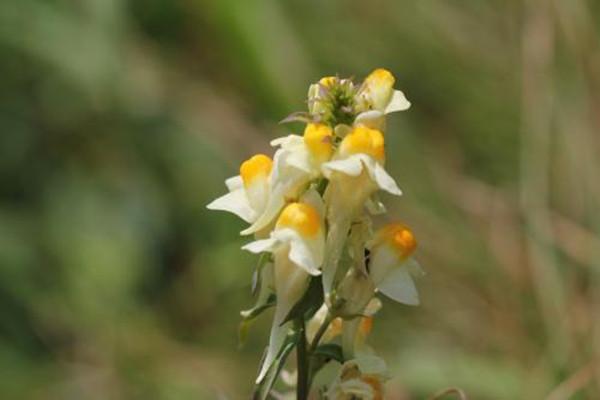
1.播种的时间
柳穿鱼一般要播种的话,那么时间都是在9月下旬到10月上旬会更加好,因为这个时候的温度和湿度都是非常满足它的生长条件的,播种下去之后,生根也更加快,营养需求也是非常的容易满足,自然成活率也是很高的。所以播种也是要选择好时间的。
2.种子的准备
在播种之前我们一般都是要先把种子准备好的,我们可以用一些温热水,先把种子放进去浸泡上12到24个小时,一直要等到它的种子吸水并且膨胀起来。但是有的种子比较好发芽,那么就不需要再浸泡了。
3.进行播种
对那些用手或者工具比较难加起来的细小种子,我们可以把牙签的一端用水沾湿了,把种子一粒粒的粘放在准备好的苗床上面,再在上面盖上1厘米厚的基质,然后把播种的花盆给放到水里面,让水慢慢的浸上来就可以了。但是对于那些比较大的种子,就可以直接把它放到基质中去了。种完之后再盖上一层细土就可以了。
4.播种后的养护
在把柳穿鱼播种进去之后,我们可以用喷雾器或者是一些孔子比较小的花洒,把它的比重基质给淋湿了,以后只要盆土比较干的时候就可以再淋水,要注意浇水的力度不能太大了,不然会把它的种子冲出来的。另外在种子还没有长出来的时候,还要对它进行适当的遮阴,不能让它直晒太阳。时刻的保持盆土是湿润的,不能够长时间的不浇水,不然就会让它的种子不容易萌发,只要这些养护都做到了,基本上要不了两星期,播进去的种子就会开始发芽长叶了。
0
2
文章
权问薇
2017年12月24日


一、施肥时间
对于果农来说,施肥的两个最佳时间段,一是9月中下旬,另一个是10月上旬到11月上旬之间,选择在这两个时间段施肥非常利于果树生长。如果因为种种原因没有在最佳时间段施肥,那么建议在第二年的春天,泥土解冻后及时施肥。

二、施肥方法
冬季对果树施肥时,方法一是在果树下的地面上,以树干为轴心,在离中干保持大约80厘米地方,开始向外挖4到6条放射状沟,外面的沟要比里面深和宽。方法二是在树冠外缘地面下挖条形沟,尽量使沟深为20到40厘米,长大约为80厘米,宽大约为40厘米,避开树的粗根。果树施入肥料后,不能马上用土壤覆盖肥料,用农具使肥料和泥土充分搅拌,之后再进行覆盖处理,不要忘记浇适量的水。

三、特别注意事项
1)植株土壤偏干的状态下尽量不要施用施碳铵作为肥料。由于碳铵化学性质很不稳定,很容易挥发。因此,使用施碳铵作为肥料时时要确保土壤湿润,在施用后,立即覆上土,减少挥发。
2)不能重复使用硫铵作为肥料。特别是在土壤呈酸性或者微碱性的果园中,很多土壤就是因为不恰当地重复使用硫铵作为肥料,导致土壤结板。这种情况下,果树会成长缓慢,这是因为影响了果树根的运输,阻碍根系发育。
3)果树用尿素作为肥料后不要马上浇水。遇到水的尿素因为化学性质,氮素会大量流失的,而果树容易吸收的是由氮元素转化而来的碳酸铵,这样一来,使得肥料养分吸收率降低,所以施肥后,过几天再给果树浇水。

0
1
文章
Miss Chen
2017年12月22日

Description: This perennial plant is unbranched or sparsely branched in the upper half, and 1-2½' tall. The pale green central stem has light longitudinal lines. The alternate compound leaves are oddly pinnate and about 2-7" long, consisting of 3-9 pale green leaflets. Each leaflet is linear or narrowly oblanceolate, about 1" long and less than ¼" across. The margins are smooth, and the underside of each leaflet has numerous translucent dots. Both the stems and leaves are hairless. There is a short cylindrical spike of white flowers at the terminus of the central stem and each of the major side stems. This spike is about 1-3" tall and ¾" across. The small flowers form a wreath around the bottom of the spike, which moves upward as the season progresses. Each flower is about ¼" across, with 5 petals and 5 white stamens. The flowers often have a pleasant fragrance. The blooming occurs during early to mid-summer and lasts about a month. The seeds fall a short distance from the mother plant when the wind shakes the cylindrical spikes. The root system consists of a central taproot that can extend 5' into the ground.
Cultivation: The preference is full sun and mesic to dry conditions. The soil can contain significant amounts of loam, clay, sand, or gravel. This plant is slow to develop, but otherwise easy. Foliar disease isn't troublesome. Drought resistance is very good.
Range & Habitat: The native White Prairie Clover occurs occasionally in scattered counties of Illinois, but it is rare or absent in the SE section of the state (see Distribution Map). Habitats include mesic to dry black soil prairies, sand prairies, savannas, openings in upland forests, and limestone glades. It is rarely observed in highly disturbed areas. Recovery from occasional wildfires is good.
Faunal Associations: The nectar and pollen of the flowers attract bumblebees, Halictid bees (including green metallic bees), plasterer bees (Colletes spp.), Sphecid wasps, Tiphiid wasps, Syrphid flies, thick-headed flies (Conopidae), and small butterflies. Two oligolectic plasterer bees, Colletes robertsonii and Colletes wilmattae, visit the flowers of White Prairie Clover (Robertson, 1929; Krombein et al., 1979). Other insects feed on the seeds, foliage, and other parts of this plant. They include such species as the larvae of two butterflies, Colias cesonia (Dogface Sulphur) and Hemiargus isola (Reakirt's Blue), the seed-eating larvae of two weevils, Apion amaurum and Apion capitone, and Melanoplus keeleri luridus (Keeler's Grasshopper); see Opler & Krizek (1984), Sauer (2005), and Campbell et al. (1974). This plant is palatable and high in protein, therefore it is readily consumed by mammalian herbivores of all kinds, including rabbits, groundhogs, deer, and livestock. This can cause difficulties in establishing this plant in some areas. It is possible that small rodents may carry the seeds to their dens. Because of their high mortality rate, some of the seeds will remain uneaten, and thus are dispersed by these rodents.

Photographic Location: Photographs were taken at the Lincoln Book Bindery in Urbana, Illinois.
Comments: White Prairie Clover often occurs in the same habitats as Dalea purpurea (Purple Prairie Clover) – the two are often seen together, although the former begins blooming about 2 weeks earlier than the latter. However, White Prairie Clover is the less common of the two plants. The most obvious difference between them is the coloration of their flowers. In addition, White Prairie Clover tends to have more elongated flowering spikes with hair-like bracts, and its foliage is longer, sparser, with a lighter shade of green. Prior to blooming, it blends into the background of grasses and other forbs rather well, and is easy to overlook.
Cultivation: The preference is full sun and mesic to dry conditions. The soil can contain significant amounts of loam, clay, sand, or gravel. This plant is slow to develop, but otherwise easy. Foliar disease isn't troublesome. Drought resistance is very good.
Range & Habitat: The native White Prairie Clover occurs occasionally in scattered counties of Illinois, but it is rare or absent in the SE section of the state (see Distribution Map). Habitats include mesic to dry black soil prairies, sand prairies, savannas, openings in upland forests, and limestone glades. It is rarely observed in highly disturbed areas. Recovery from occasional wildfires is good.
Faunal Associations: The nectar and pollen of the flowers attract bumblebees, Halictid bees (including green metallic bees), plasterer bees (Colletes spp.), Sphecid wasps, Tiphiid wasps, Syrphid flies, thick-headed flies (Conopidae), and small butterflies. Two oligolectic plasterer bees, Colletes robertsonii and Colletes wilmattae, visit the flowers of White Prairie Clover (Robertson, 1929; Krombein et al., 1979). Other insects feed on the seeds, foliage, and other parts of this plant. They include such species as the larvae of two butterflies, Colias cesonia (Dogface Sulphur) and Hemiargus isola (Reakirt's Blue), the seed-eating larvae of two weevils, Apion amaurum and Apion capitone, and Melanoplus keeleri luridus (Keeler's Grasshopper); see Opler & Krizek (1984), Sauer (2005), and Campbell et al. (1974). This plant is palatable and high in protein, therefore it is readily consumed by mammalian herbivores of all kinds, including rabbits, groundhogs, deer, and livestock. This can cause difficulties in establishing this plant in some areas. It is possible that small rodents may carry the seeds to their dens. Because of their high mortality rate, some of the seeds will remain uneaten, and thus are dispersed by these rodents.

Photographic Location: Photographs were taken at the Lincoln Book Bindery in Urbana, Illinois.
Comments: White Prairie Clover often occurs in the same habitats as Dalea purpurea (Purple Prairie Clover) – the two are often seen together, although the former begins blooming about 2 weeks earlier than the latter. However, White Prairie Clover is the less common of the two plants. The most obvious difference between them is the coloration of their flowers. In addition, White Prairie Clover tends to have more elongated flowering spikes with hair-like bracts, and its foliage is longer, sparser, with a lighter shade of green. Prior to blooming, it blends into the background of grasses and other forbs rather well, and is easy to overlook.
0
0
文章
权问薇
2017年12月18日


1.播种的时间
柳穿鱼一般要播种的话,那么时间都是在9月下旬到10月上旬会更加好,因为这个时候的温度和湿度都是非常满足它的生长条件的,播种下去之后,生根也更加快,营养需求也是非常的容易满足,自然成活率也是很高的。所以播种也是要选择好时间的。

2.种子的准备
在播种之前我们一般都是要先把种子准备好的,我们可以用一些温热水,先把种子放进去浸泡上12到24个小时,一直要等到它的种子吸水并且膨胀起来。但是有的种子比较好发芽,那么就不需要再浸泡了。

3.进行播种
对那些用手或者工具比较难加起来的细小种子,我们可以把牙签的一端用水沾湿了,把种子一粒粒的粘放在准备好的苗床上面,再在上面盖上1厘米厚的基质,然后把播种的花盆给放到水里面,让水慢慢的浸上来就可以了。但是对于那些比较大的种子,就可以直接把它放到基质中去了。种完之后再盖上一层细土就可以了。
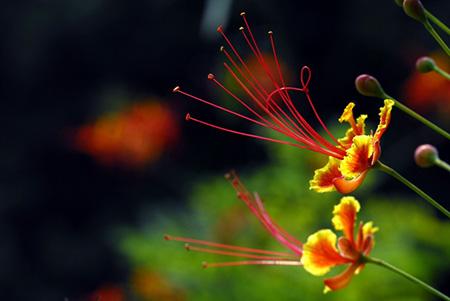
4.播种后的养护
在把柳穿鱼播种进去之后,我们可以用喷雾器或者是一些孔子比较小的花洒,把它的比重基质给淋湿了,以后只要盆土比较干的时候就可以再淋水,要注意浇水的力度不能太大了,不然会把它的种子冲出来的。另外在种子还没有长出来的时候,还要对它进行适当的遮阴,不能让它直晒太阳。时刻的保持盆土是湿润的,不能够长时间的不浇水,不然就会让它的种子不容易萌发,只要这些养护都做到了,基本上要不了两星期,播进去的种子就会开始发芽长叶了。
0
0
文章
Miss Chen
2017年12月14日

Description: This perennial plant is 1½–3½' tall, branching occasionally. The ridged stems are pubescent. The alternate compound leaves are odd pinnate, and 5-9" long, with about 21-31 leaflets. The oblong leaflets are about 1½" long and 3/8" across, with smooth edges. From the upper axils of the compound leaves there occasionally develops a whorled raceme of flowers from a stout stalk. A raceme (including the stalk) is usually about 1-2" longer than the compound leaves subtending it, or about 7-11" long. A typical raceme is crowded with about 75 creamy flowers, which may have yellow or green tints. Each flower is about ¾" long and tubular-shaped, although jutting slightly upward toward the outer tip. It consists of five petals, including a curved upper hood, a lower keel, and close-fitting side petals. The blooming period occurs during the summer and lasts about 2-3 months. There is no noticeable floral scent. The flowers are replaced by stout oval pods with long pointed tips, which are held nearly erect on the stalk. The root system consists of a taproot.
Cultivation: The preference is full or partial sun and mesic conditions. Canada Milkvetch grows well on most kinds of soil, and probably fixes some nitrogen. It's a robust plant, although the foliage sometimes turns prematurely yellow. This plant has a tendency to sprawl, unless it receives support from adjacent vegetation.
Range & Habitat: The native Canada Milkvetch occurs occasionally in the northern half of Illinois, but it is rather uncommon in most areas of southern Illinois (see Distribution Map). Habitats include moist to slightly dry black soil prairies, sand prairies, typical and sandy savannas, thickets and woodland borders, moist meadows near rivers, and abandoned fields.

Faunal Associations: Primarily bumblebees visit the flowers for nectar. Other long-tongued bee visitors include honeybees and Megachile spp. (Large Leaf-Cutting Bees). Insects with shorter mouthparts have trouble reaching the nectar, nor is the pollen easy to access. Unlike many milkvetches of the Western states, the foliage of Canada Milkvetch is non-toxic and palatable to mammalian herbivores, including deer, groundhogs, rabbits, and livestock. This plant may be difficult to establish where these animals occur in abundance. The seeds may be eaten occasionally by the Wild Turkey and other upland gamebirds, as well as small rodents, such as the Thirteen-Lined Ground Squirrel; however, such observations are confined largely to the Western states, where Astragalus spp. are more abundant.

Photographic Location: The wildflower garden of the webmaster in Urbana, Illinois.
Comments: There are very few Astragalus spp. that occur in Illinois. Canada Milkvetch has a distinctive appearance on account of its size (up to 3½' tall) and abundant creamy flowers (about 75 per raceme). Some pale-flowered vetches are superficially similar in appearance, such as Vicia carolina (Carolina Vetch). However, vetches are vine-like plants with tendrils, while Canada Milkvetch is a semi-erect plant without tendrils (although it may clamber over adjacent vegetation, nonetheless). Another difference is the inflorescence: the raceme of Canada Milkvetch is whorled with about 75 flowers, while Vicia spp. have one- or two-sided racemes with fewer flowers.
Cultivation: The preference is full or partial sun and mesic conditions. Canada Milkvetch grows well on most kinds of soil, and probably fixes some nitrogen. It's a robust plant, although the foliage sometimes turns prematurely yellow. This plant has a tendency to sprawl, unless it receives support from adjacent vegetation.
Range & Habitat: The native Canada Milkvetch occurs occasionally in the northern half of Illinois, but it is rather uncommon in most areas of southern Illinois (see Distribution Map). Habitats include moist to slightly dry black soil prairies, sand prairies, typical and sandy savannas, thickets and woodland borders, moist meadows near rivers, and abandoned fields.

Faunal Associations: Primarily bumblebees visit the flowers for nectar. Other long-tongued bee visitors include honeybees and Megachile spp. (Large Leaf-Cutting Bees). Insects with shorter mouthparts have trouble reaching the nectar, nor is the pollen easy to access. Unlike many milkvetches of the Western states, the foliage of Canada Milkvetch is non-toxic and palatable to mammalian herbivores, including deer, groundhogs, rabbits, and livestock. This plant may be difficult to establish where these animals occur in abundance. The seeds may be eaten occasionally by the Wild Turkey and other upland gamebirds, as well as small rodents, such as the Thirteen-Lined Ground Squirrel; however, such observations are confined largely to the Western states, where Astragalus spp. are more abundant.

Photographic Location: The wildflower garden of the webmaster in Urbana, Illinois.
Comments: There are very few Astragalus spp. that occur in Illinois. Canada Milkvetch has a distinctive appearance on account of its size (up to 3½' tall) and abundant creamy flowers (about 75 per raceme). Some pale-flowered vetches are superficially similar in appearance, such as Vicia carolina (Carolina Vetch). However, vetches are vine-like plants with tendrils, while Canada Milkvetch is a semi-erect plant without tendrils (although it may clamber over adjacent vegetation, nonetheless). Another difference is the inflorescence: the raceme of Canada Milkvetch is whorled with about 75 flowers, while Vicia spp. have one- or two-sided racemes with fewer flowers.
0
0








